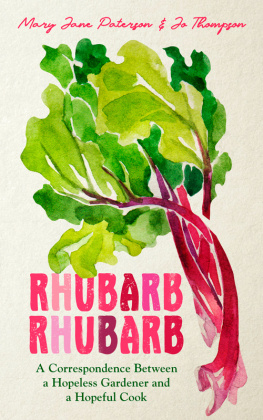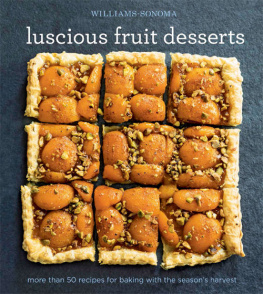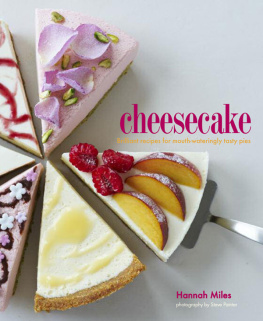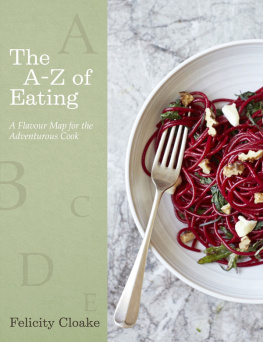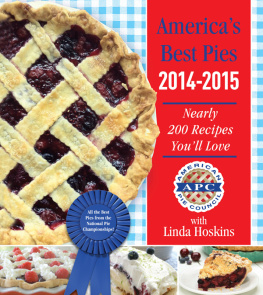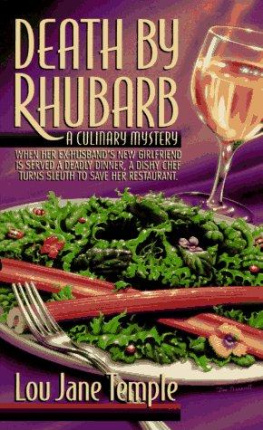Great Rhubarb Recipes
Nancy C. Ralston & Mar ynor JordanIntroduction
Good, old-fashioned rhubarb has been around for a very long time. Thought by many to be a fruit, rhubarb actually is a perennial vegetable. When sweetened, its bitter stalks mix well with many fruits, especially strawberries, which conveniently ripen at the same time. The sturdy perennial plants are very easy to grow. Once established in the garden, rhubarb will faithfully push its way through the soil regardless of the weather.
As one country humorist put it long ago, Nothing retards rhubarb; it could get out of a straitjacket. Cultivated for medicinal purposes, rhubarb was grown in China for several centuries before it was introduced in the Western world late in the sixteenth century. However, not until 300 years later did its edible qualities truly become appreciated. At that time, rhubarb was known as pieplant. Its colorful stalks were carefully gathered each spring to be used for cobblers and pies throughout the early growing season. As the recipes in this bulletin reflect, however, rhubarb no longer is grown just for pie. There are many other ways to prepare and enjoy this vegetable.
Do not eat the leaves is the rhubarb watchword. The leaves of this plant contain oxalic acid and can be toxic. Be sure to use only the stalks in recipes.
Growing Your Own Rhubarb
Growing rhubarb is easy, even for people who have no green thumb. It requires very little care weeding and a feeding every fall and deserves to be in every garden. Rhubarb likes rich, slightly acid, fertile soil with lots of organic matter.
Purchase either root divisions or container-grown plants. Select a site in sun or light shade, and plant in early spring, a few weeks before the last frost. Plant divisions 18 to 24 inches apart with the buds about 2 inches below the soil surface. Water well after planting and keep the soil moist throughout the growing season. Snip off any flower shoots as they appear. Once established, rhubarb plants grow rapidly and often become crowded within 5 to 10 years.
To rejuvenate the plants, divide them in fall by slicing the crown with a sharp shovel. Dig up and remove one portion of the plant, fill the hole with soil, and replant crown sections. Generally you may harvest a small crop of rhubarb after the first year although if you can resist this temptation, the plants will be hardier the following year. Its best to wait until the third year to harvest all you want. Rhubarb is most flavorful in cool spring. The varieties Valentine and Strawberry have an especially vivid red color, while Cherry Giant likes warmer weather more than most other rhubarbs.
Harvest by grasping the stem near the base and pulling up; give the stem a twist as you pull. You can also cut the stem from the plant with a sharp knife.
Choosing & Using Rhubarb
Choose stalks that are firm and crisp, without blemishes. The leaves should look fresh and be blemish-free as well. Rhubarb wilts rapidly and will stay fresh in the refrigerator for up to 3 days; wrap it tightly in a plastic bag. If the leaves are still on, wash and remove them just before using the stalks.
Trim off the leaf ends and lower ends of the stalks; wash the stalks. Some fibrous stems may need to be pared; you can also pull off the strings as for celery. To freeze rhubarb, wash and cut into small pieces. Remove tough stalks. Blanch for 1 minutes in steam or boiling water and pack into freezer containers or plastic bags. You may also freeze it in syrup without blanching it.
A simple sugar syrup for freezing may be made by mixing one part sugar with two parts water, bringing the mixture to a boil to dissolve the sugar, then refrigerating the mixture until chilled. Add to cup of cold sugar syrup to a 2-cup container packed with clean rhubarb, allowing inch of headspace. Mix gently, label, and freeze. Use Nonreactive Pans When cooking rhubarb, you should always use nonreactive pans, such as anodized aluminum, stainless steel, Teflon-coated aluminum, or enamel-coated cast iron cookware. Rhubarb cooked in reactive metal pots (aluminum, iron, and copper) will turn an unappetizing brown color. Rhubarb is sometimes eaten raw, with a little sugar or salt, but most often its cooked in one of the ways described in this booklet.
Cut into -inch pieces, rhubarb cooks, in a small quantity of water over moderate heat, in about 10 minutes. It is done when the fibers become soft. Rhubarb Math 1 pound rhubarb equals 4 to 8 stalks 1 pound rhubarb yields 4 cups sliced 1 pound rhubarb yields 2 cups chopped and cooked
Rhubarb at Breakfast, Lunch & Dinner
Because its technically a vegetable but most often treated as a fruit, rhubarb is versatile enough to be used at any meal.
Rhubarb Nut Bread
Serve this bread warm with butter for breakfast, then enjoy the leftovers with your afternoon tea.Toppingcup brown sugarcup chopped nutsteaspoon ground cinnamon1 tablespoon butterBatter2 cups flour1 cups brown sugar1 teaspoon baking soda1 teaspoon salt1 cups fresh or frozen diced rhubarb1 cup buttermilkcup cooking oil1 egg1 teaspoon vanilla extract 1. Preheat oven to 350F and grease two 9- by 5-inch loaf pans. 2.
To make the topping, mix the brown sugar, nuts, and cinnamon. Blend the butter in with your fingers until well mixed. Refrigerate. 3. In a large mixing bowl, combine the flour, brown sugar, baking soda, and salt. 4. 4.
Add the buttermilk, oil, egg, and vanilla. Stir until just combined. Divide the batter evenly between the prepared pans. 5. Sprinkle half of the topping mixture evenly over each loaf. 6.
Bake for 45 to 60 minutes or until a tester inserted near the center comes out clean. Cool for 10 minutes on a wire rack; turn loaves upside down on the rack to cool further before removing pans. MAKES 2 LOAVES
Rhubarb-Orange Sauce
This recipe is at home on pound cake or ice cream, but we enjoy it most as an alternative to maple syrup on our pancakes and waffles.4 cups chopped (-inch pieces) rhubarb1 cup sugarcup orange juiceteaspoon ground cinnamon 1. Combine all ingredients in a microwave-safe dish. 2. Cover and microwave on high for 8 minutes, until the rhubarb is tender.
Stir twice during cooking. SERVES 4 
Rhubarb Fritters
Dipped in pure maple syrup, these treats tame rhubarbs tartness.Oil for frying1 cup flourcup milk2 eggs, separated1 tablespoon butter, melted1 cup plus 1 tablespoon sugar2 cups chopped rhubarbPure maple syrup or confectioners sugar (optional), for serving 1. Heat oil 2 to 3 inches deep in a large skillet or saucepan to 375F on a deep-fat thermometer. 2. In a medium-sized mixing bowl, blend well the flour, milk, egg yolks, butter, and 1 tablespoon of the sugar. 3.
Beat the egg whites in a small bowl until they form soft peaks. Fold them into the flour mixture. 4. In a medium-sized bowl, coat the rhubarb pieces in the remaining 1 cup of sugar, then fold the pieces into the batter. 5. Drop fritters by tablespoonsful into the oil and cook, turning once, until golden brown, 5 to 7 minutes.


